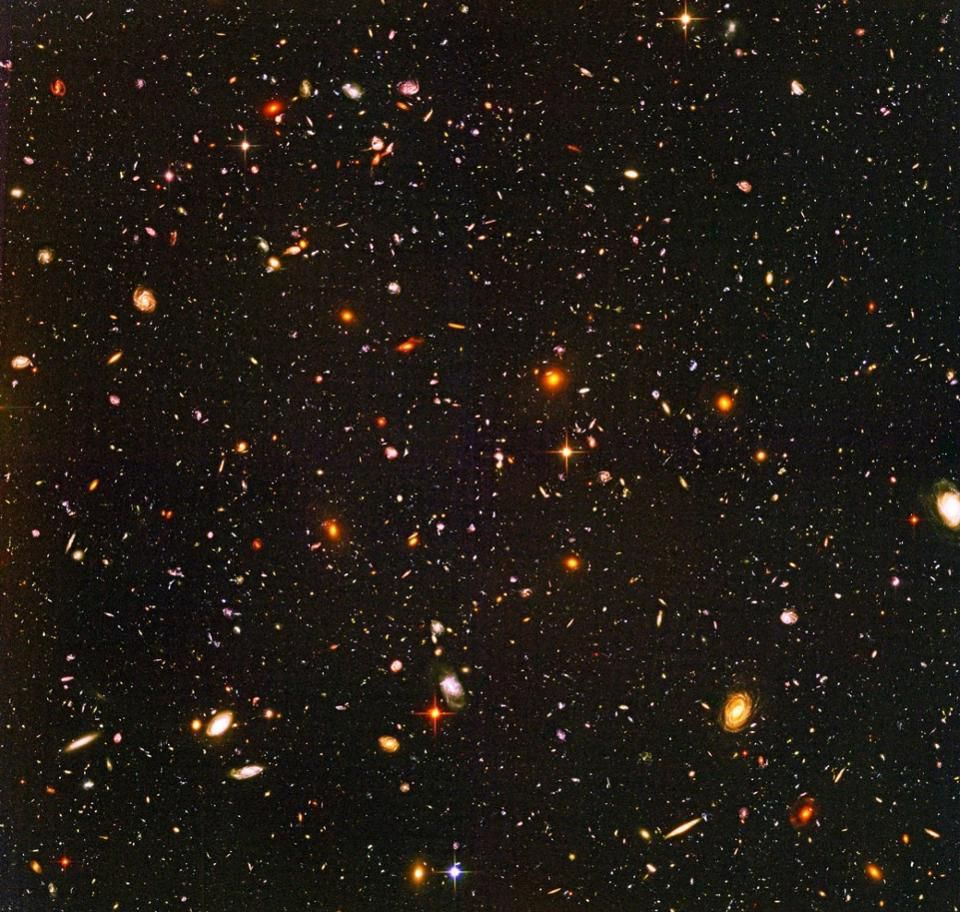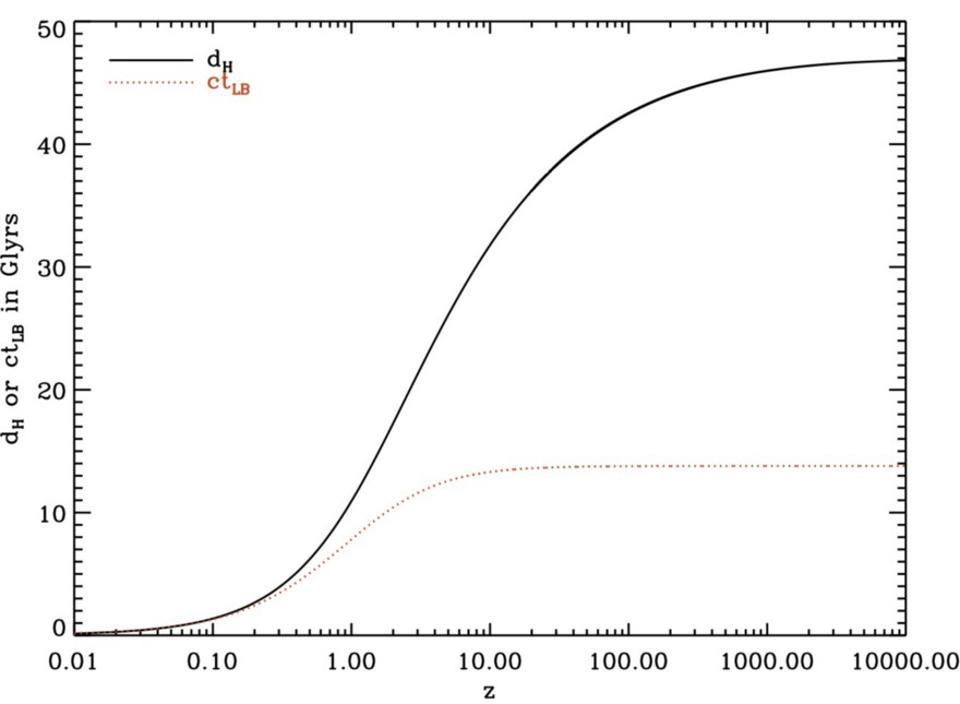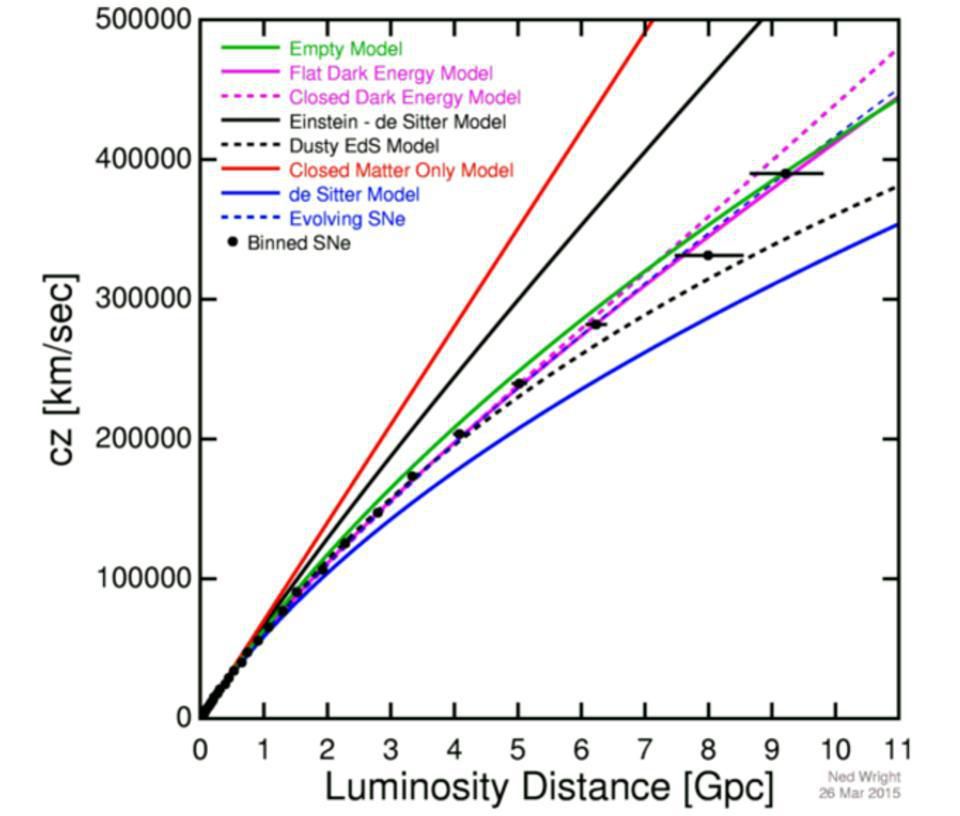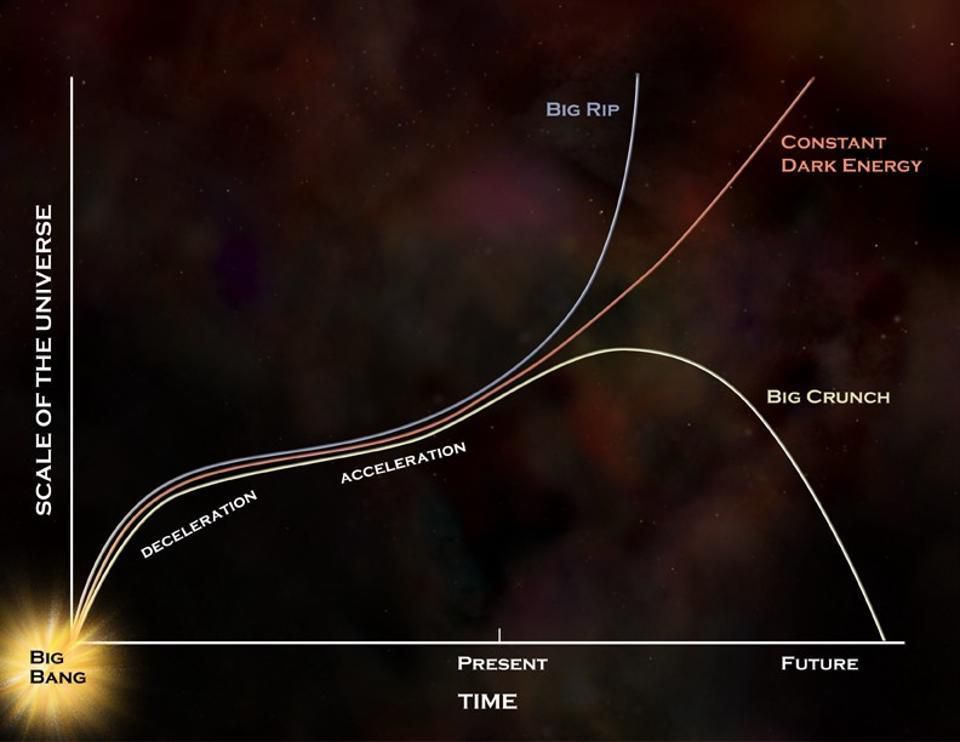 A glance at an extremely distant part of the Universe reveals galaxies moving from us at enormous speeds. At such distances, the galaxies are more visible, they are smaller in size, not so developed and are removed with large redshifts than those that are located nearby
A glance at an extremely distant part of the Universe reveals galaxies moving from us at enormous speeds. At such distances, the galaxies are more visible, they are smaller in size, not so developed and are removed with large redshifts than those that are located nearbyWhen you look at the distant Universe, you see galaxies everywhere - in all directions, for all millions and billions of light years. Mankind has about two trillion galaxies to observe, and the total amount of everything in the Universe is much larger and more incredible than most of us can imagine. One of the most confusing facts is that all the galaxies we see on average obey one rule: the farther they are from us, the faster, apparently, they are moving away from us. This discovery, made by Edwin Hubble and his assistants in the 1920s, led us to a picture of an expanding universe. But what does it mean that the universe is expanding? Science knows this, and now you will know!
 The further we look, the more ancient and undeveloped Universe is visible. But this is only if the General Theory of Relativity is applicable to the Universe and controls its expansion.1) What is the Universe expanding into?
The further we look, the more ancient and undeveloped Universe is visible. But this is only if the General Theory of Relativity is applicable to the Universe and controls its expansion.1) What is the Universe expanding into? This is one of the questions that sound reasonably, because everything else that can expand, is made up of matter and exists within the framework of space and time of the Universe. But the Universe itself is space and time, and it contains all the matter and energy available. Speaking about the “expansion of the Universe”, we mean that space is expanding, and we see that separate galaxies and their clusters fly apart from each other. The best visualization of this process is the dough with raisins, rising as a result of baking in the oven.
 Model of "bread with raisins" expansion of the Universe, in which the relative distances increase with the expansion of space (dough).
Model of "bread with raisins" expansion of the Universe, in which the relative distances increase with the expansion of space (dough).The dough is a fabric of space, the raisins are connected structures (galaxies or clusters of galaxies), and from the point of view of any raisin all the others move from it, and the farther the raisin is, the faster it escapes. Only in the case of the Universe there is no stove and no air outside the test; there is only dough (space) and raisins (matter).
 The redshift is not caused by the movement of galaxies from us — the redshift of light traveling from distant points of space to us is due to the stretching of the space between us and the galaxies.2) How do we know that the fabric of space is expanding - maybe these are just galaxies moving at different speeds?
The redshift is not caused by the movement of galaxies from us — the redshift of light traveling from distant points of space to us is due to the stretching of the space between us and the galaxies.2) How do we know that the fabric of space is expanding - maybe these are just galaxies moving at different speeds? If objects move from you in all directions, then perhaps the space between you and them expands; but this is only one of the possibilities. It also sounds reasonable that you could be at the center of the explosion, and many of the objects were just farther away from you and moving faster today because you gained more energy during the explosion. If this were so, then two evidences of this would stand out:
- At large distances, galaxies with high velocities would be smaller, since they would be scattered to the sides in space with the passage of time.
- The ratio of redshift and range over large distances would have a very definite form, different from the case when the fabric of space expands.
 The difference between an explanation based on simple motion (dotted line) and GRT predictions (solid) for distances in an expanding universe. Our observations clearly correspond to the predictions of GR.
The difference between an explanation based on simple motion (dotted line) and GRT predictions (solid) for distances in an expanding universe. Our observations clearly correspond to the predictions of GR.At large distances, the density of galaxies is higher than near us. This coincides with the picture in which the space expands, because looking into the distance is the same as looking into the past, where the expansion was not so strong. We also see that the ratio of redshift to distance in distant galaxies coincides with the pattern of expansion of the fabric of space, and does not at all coincide with the case when galaxies simply move from us. Science answers this question in two very different ways, and both answers support the option of an expanding universe.
 The graph of the apparent expansion rate (y-axis) versus distance (x-axis) coincides with the Universe, which has expanded faster in the past, but is still expanding today. This is a modern version of the observation, extending the distance in a thousand times compared with what Hubble did. Note that the points do not lie on a straight line, which indicates a change in the rate of expansion with time.3) Has the universe always expanded at the same speed?
The graph of the apparent expansion rate (y-axis) versus distance (x-axis) coincides with the Universe, which has expanded faster in the past, but is still expanding today. This is a modern version of the observation, extending the distance in a thousand times compared with what Hubble did. Note that the points do not lie on a straight line, which indicates a change in the rate of expansion with time.3) Has the universe always expanded at the same speed? We call this speed Hubble constant, but it is constant throughout the whole space, not all the time. The Universe is expanding more slowly now than it was in the past. [
Here is where Ethan explains why expansion slows down and galaxies fly faster and faster / approx. trans.]. When we talk about the speed of expansion, we mean the speed per unit of distance: today it is about 70 km / s / Mpc (kilometers per second per megaparsec; megaparsec - 3,260,000 light years). But the rate of expansion depends on the density of everything in the Universe, including matter with radiation. With the expansion of the Universe, matter and the radiation inside it become less dense, and with a decrease in the density of matter and radiation, the expansion rate also decreases. The universe has expanded faster in the past, and has slowed since the hot big bang. Hubble's constant is not so accurately named; it should be called the Hubble parameter.
 Variants of the remote destiny of the Universe offer several possibilities, but if dark energy is indeed constant, as our data indicate, the Universe will continue to follow the red curve4) Will the universe expand forever, or will it ever stop, or even shrink back?
Variants of the remote destiny of the Universe offer several possibilities, but if dark energy is indeed constant, as our data indicate, the Universe will continue to follow the red curve4) Will the universe expand forever, or will it ever stop, or even shrink back? For many generations, this question was the holy grail of cosmology and astrophysics, and it could only be answered by determining both the rate of expansion of the Universe and all types and quantities of energy present in it. Now we have successfully measured how much normal matter, radiation, neutrinos, dark matter and dark energy are present in it, as well as the rate of expansion of the Universe. Based on the laws of physics and past events, it seems very likely that the Universe will expand forever. Although this probability is not equal to 100%; if something, for example, dark matter, will behave differently in the future, not like in the past or today, all our conclusions will have to be reconsidered.
5) Are there galaxies escaping from us faster than the speed of light, and is it not forbidden? From our point of view, the space between us and any remote point expands. The farther away something is, the faster it moves away from us. Even if the expansion speed were tiny, a far enough object would eventually overcome the threshold of any final speed, since the expansion speed (speed per unit distance) multiplied by a sufficiently large distance will give you any speed value. But GR does not prohibit this! The law prohibiting movement faster than light applies only to the movement of objects in space, and not to the expansion of space itself. In fact, the galaxies themselves are moving at speeds of the order of hundreds or thousands of km / s, which is much less than 300,000 km / s, the speed limit set by the light. The runaway and redshift are caused by the expansion of the Universe, and not by the true movement of the galaxy.
 Inside the observable universe (yellow circle) there are about 2 trillion galaxies. Galaxies located at a distance greater than a third of the way from us to the border can never be reached due to the expansion of the Universe, therefore the volume open for human study is only 3% of the observed Universe
Inside the observable universe (yellow circle) there are about 2 trillion galaxies. Galaxies located at a distance greater than a third of the way from us to the border can never be reached due to the expansion of the Universe, therefore the volume open for human study is only 3% of the observed UniverseThe expansion of the Universe is an obligatory consequence of the presence of matter and energy that fills space-time, subject to GR. As long as there is matter, there is gravitational attraction, therefore either gravity wins and everything shrinks, or gravity loses and wins expansion. There is no center of expansion, there is nothing outside the space where the Universe would expand; expansion is itself the fabric of the universe, everywhere and constantly. And what is the most offensive, even if we left Earth today and set off at the speed of light, only 3% of galaxies from the entire observable Universe would be accessible to us; 97% of them are already beyond our reach. The universe may be a tricky place, but at least you now know the answers to five of the most frequently confusing all questions!